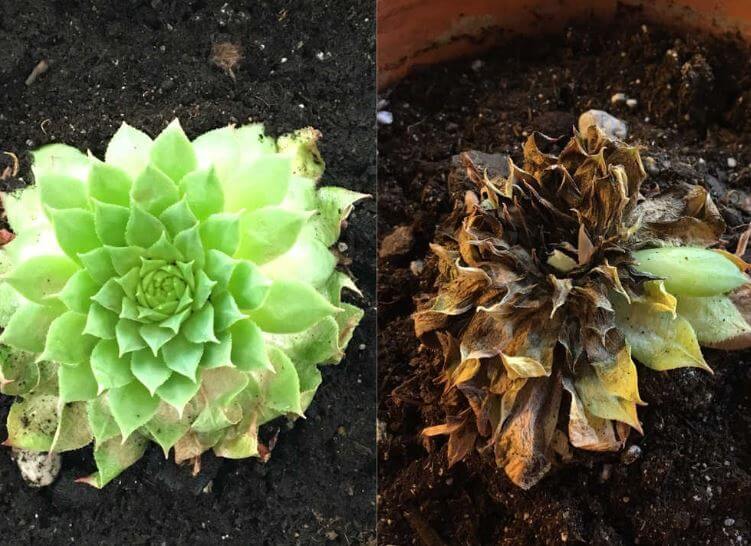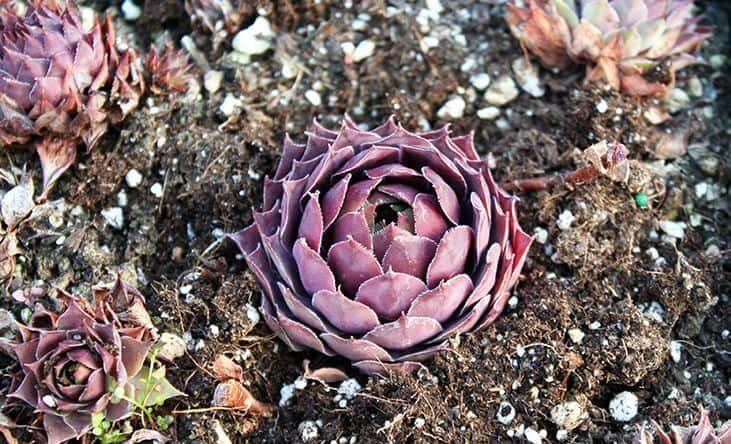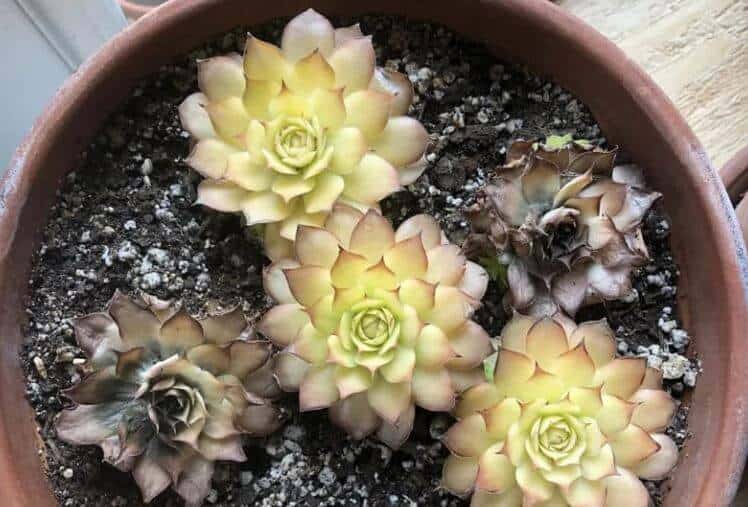Last Updated on February 16, 2023 by a Friendly Gardener
Botanically named the Sempervivum tectorum, this popular succulent hails from Europe and Africa. It forms an attractive mat growth filled with rosettes characterized by fleshy and pointed leaves. It is popularly called a Hen and Chicken plant because the main plant (the Hen) will produce numerous offsets (the chicks) along a thin stem or runner. It is no wonder that this plant is called “sempervivum” literally translated from Latin as “always alive” due to its uninterrupted reproduction efforts.
Why Is My Hen and Chick Plant Dying?

A Hen and Chick plant may become ill for various reasons such as overwatering underwatering, improper light, a lack of nutrients, pests, infections, and even improper humidity. Here are the more common problems that afflict Hen and Chick plants and how to intervene before they prove to be fatal.
Watering Issues

Overwatering
As a succulent, the Hen and Chick plant is a perennial that is drought tolerant and can go without water for weeks. Excessive watering will kill this plant. An overwatered unhealthy Hen and Chick plant will be characterized by mushy, rotting foliage.
If you have overwatered, let the soil bed dry thoroughly before resuming watering. If overwatering is severe, your succulent needs to be repotted in fresh soil that has been specially formulated for succulents and cacti.
Underwatering
Although this plant is a succulent and can survive for extended periods without water, it cannot survive without it. Weeks without water should never turn into months. This is particularly true if the plant has been recently transplanted. Without adequate water, the foliage will dry out, appear dehydrated, and wither before dying.
Attempt to maintain a watering schedule. Once a week should be more than sufficient. In cooler seasons, once every ten days to two weeks should suffice depending on the environmental temperature. In hot weather, you may want to increase the watering frequency, but always check the soil before doing so.
Improper Drainage
If the soil bed is not draining properly and the soil becomes waterlogged or soggy, these conditions can lead to the rotting of your plant. If you feel you have not overwatered, you may have a case of poor drainage. Soggy soil can also create the ideal environment for fungal infections.
Your Hen and Chick plant should only be planted in well-draining soil, and preferably in soil blended for succulents. If you are using potting soil, add peat moss and sand to your soil bed to improve drainage capabilities and soil aeration. Also, check the container’s drainage holes to verify if they are blocked.
Nutrition and Fertilization

A Lack of Nutrients
Hen and Chick plants can thrive in a variety of growing mediums from gravel to poor-quality soil, in between rocks, or in cracks and crevices. However, if they are unable to procure sufficient nutrients they will begin to suffer.
If your plant is not showing signs of growth and is not producing chicks, then consider fertilizing it with a fertilizer formulated for succulents. If your plant is doing well, even in nutrient-poor soil, leave it alone and do not fertilize it.
Light Issues
If your Hen and Chick plant does not receive enough sunlight, its foliage will shrivel and dry out. This is because the plant will not be able to photosynthesize to nourish itself. Without nourishment, growth will appear stunted, and your plant will begin to die.
A Hen and Chick plant loves sunlight and lots of it. Place your plant in a spot with generous sunlight to aid its growth.
Excessive Humidity
These succulents do not thrive in humid environments. If the humidity is too high, it may enter a semi-dormancy, and in worst-case scenarios, it may provoke rotting. Improper watering as well as wetting foliage can raise humidity.
Do not place your plant in humid spots like kitchens or bathrooms when cultivating indoors. Find a dry spot for this succulent. Never water above the plant but water directly into the soil bed. Avoid misting so that foliage remains dry.
Disease and Infection

Diseases that affect the Hen and Chick plant are usually fungal. These fungi will develop in overly moist conditions as is root rot which can be fatal. The crown of the plant can also rot if left in waterlogged soil. Several Hen and chick species can also become infected with Adenophyllum Rust disease. This disease will cause a malformation of leaves and withering.
The best option for fungal infections is prevention. Keep your plant in a dry environment.
Pest Infestations
A bit surprisingly hen and Chick plants can fall prey to infestations by mealybugs and aphids, particularly if cultivated indoors in very moist or humid conditions. Pests will damage foliage and even eat your plant. Mealybugs are especially dangerous as they will feed on the plant and infect any other nearby.
Check your plant for evidence of a pest invasion. Mealybugs will leave cottony whitish deposits on and below leaves as well as in the joints of stems. Isolate your plant if it is near other houseplants. Remove bugs manually with a cotton ball dipped in rubbing alcohol. Treat your plant with an organic Neem oil spray to eliminate all insects.
Natural Aging and Life Cycle – Hens and Chicks Death Bloom

The Hen and Chick plant belongs to a type of plant known as monocarpic. Hen and Chicks plants are not known for flowering, yet flower they do. When they begin to flower, they have come to the end of their natural life cycle. Flowering in these plants is known as the Hens’ and Chicks’ death bloom.
The center of the plant will gradually begin to grow upward until it takes the form of a flower stalk. The foliage on the tip of the flower stalk will begin to move back to reveal a bud cluster. The flower buds will eventually open into petite, star-shaped pink blossoms. Occasionally flowers can be yellow, white, or red.
These plants generally will not bloom for several years. Before flowering the plant will continue to produce its little plantlets. When the mother plant dies, the offsets contribute to the impression that this plant lives forever.
Stress and overcrowding can cause these succulents to flower sooner. While some monocarpic plants can avoid death by removing the flowers, unfortunately, the Hen and Chick plant cannot be saved, if you remove the flower, the plant will still die.

